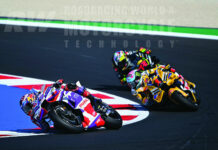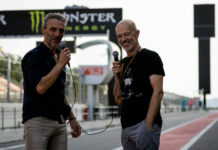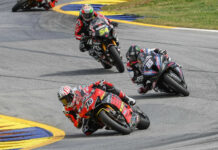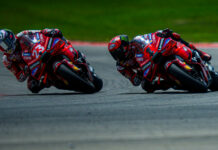Copyright 2002, Roadracing World Publishing, Inc.
Interview by David Swarts
After a lengthy and relatively successful partnership in the premier class of World Championship motorcycle road racing, Red Bull, Yamaha and the World Championship Motorsports (WCM ) team have all gone their separate ways.
Red Bull (an Austrian company) will sponsor a new factory 125cc Grand Prix effort fielded by KTM (another Austrian company) in the 2003 World Championship Series before backing KTM’s four-stroke MotoGP racer in 2004 or 2005.
Yamaha, which leased motorcycles and supplied parts and technical support to WCM, will re-focus its efforts on its remaining MotoGP teams’ development of the YZR-M1.
But what about WCM and its two guaranteed spots on the 2003 MotoGP grid? Roadracingworld.com called WCM Director of Racing (and former Roadracing World Grand Prix Editor) Peter Clifford, to find out.
Roadracingworld.com: What’s your team’s situation?
Peter Clifford: “It’s a great situation. We’ve got no riders, no motorcycles, no money, but apart from that we’re fine.” (laughs)
RW: What happened to the Red Bull sponsorship?
PC: “They decided that spending more money than they had in previous years and still (there) being no guarantee of being able to beat Valentino Rossi wasn’t such a bright idea. So they decided to call it a day, which is fair enough. They’ve been with us for six years. They’ve been a superb sponsor. All good things come to an end.”
RW: You mean, they wanted to win races more than they were concerned with the nationality of the rider or the brand of the bike?
PC: “That’s right. They were very happy in 2000. We won three races with Garry (McCoy). And that’s great. Then he was injured a good portion of 2001, and for 2002, and he didn’t win any races. And you know, Nori Haga didn’t enjoy riding the 500 or on Michelins in 2001 when he was our number 2 rider to Garry.
“And of course this year, we had John (Hopkins) riding for us. Although he did a fantastic job, of course, he was young and inexperienced and couldn’t be expected to run at the front. Then, of course, in the second half of the year when Garry got back on the bike after recovering from his broken leg and John gained more experience, the chances of really succeeding with a 500 against the ever-improving four-strokes had pretty much gone.”
RW: So Red Bull didn’t see any potential value in John Hopkins’ racing next year or his exposure for the American market?
PC: “They saw potential in him, and I believe he’ll still be a Red Bull rider next year but on a Suzuki, not with us.”
RW: The way I understand it, Hopkins had a multi-year agreement with your team. How did it work out for him to go to Suzuki?
PC: “We reached an agreement with him to sign him off to go to ride for Suzuki. He wanted to ride a factory bike, and we didn’t have one that we could guarantee for him. When the crunch came, he said he wanted to go to Suzuki.”
RW: And that was OK with you?
PC: “Well, of course, it’s disappointing, but it’s a situation that neither party would have wished to create. It’s something that happens with the best in the world. Sponsor and motorcycle situations don’t always work out the way you hope they will.”
RW: How did your relationship with Yamaha go through the year?
PC: “We’d had some disappointments with Yamaha through 2001 with a couple of things that had happen. We were looking for a new partner and thought we had found that in Moriwaki, to build us bikes with the V5 Honda engines. Moriwaki were optimistic that they could find the sponsorship to fund the technical package, the motorcycles and engines and so forth. And we would have the budget to run the team with the Red Bull sponsorship. But when the crunch came, Moriwaki had not been able to find nor had we been able to find the money to fund the motorcycles.
“Red Bull was faced with covering the entire budget. And it was at that stage that they said, ‘Well, you haven’t had any success the last couple of years, this is considerably more money than we’ve put in the last couple of years, and even with all of this are you likely to beat Valentino Rossi?’ Of course, the answer is there are certainly no guarantees. And it was a lot more money.
“So that’s where the Moriwaki Honda deal sort of came apart. I mean, having told everybody including Yamaha that we intended to run Moriwaki Hondas, it was unlikely that Yamaha was going turn around and say, ‘Sorry to hear all of that’s fallen apart. Why don’t you have these motorcycles?’ We didn’t even ask them because we didn’t have the money for Yamahas any more than we had the money for Moriwaki Hondas.”
RW: Your team still has two spots on next year’s grid. What are the plans for next year?
PC: “We’ve hung on sort of talking to people and hoping to find a sponsorship for factory bikes and all that sort of thing. Well, it’s got to the stage where it’s no sense in dreaming about that anymore. We’ve got to get realistic. So we basically have two technical possibilities we’ve been discussing this week since Valencia.
“Went to see Harris Performance Products in Hartford, England, and they’re prepared to put together a rolling chassis that (works) around a much modified R1 engine that their engine people say that can immediately, almost immediately produce 180 horsepower. With work, it could turn out 200 horsepower, which wouldn’t be too shabby. I mean, if you look at any of the Superbike lap times, they’re not slow. So if you have a 1000cc Superbike that weighs just about 20 kilograms (44 pounds) less than a Superbike weight limit, then you’ve got something that’s quite powerful. I mean, whether we can get an R1-engined bike down to the (MotoGP four-cylinder) weight limit, 145 kilos (320 pounds), immediately is questionable, but obviously that would be the aim.
“The other possibility is the company that owns the NCR Ducati, an Italian company called Poggipolini. They run the NCR Ducati team in World Superbike, and they are specialists in making high-tech titanium stuff for everybody from Ferrari to Augusta helicopters. What they have proposed is a very special bike based on a Superbike Ducati but using titanium crankcases and things like a titanium swingarm and loads of other stuff, hopefully, to bring the weight down from 162 kilos (356 pounds) to 135 kilos (297 pounds), which is the twin-cylinder MotoGP weight limit. And if they can achieve that, then we’ve got something that which is very, very potent, obviously. They’ve just rolled out a racebike with the air-cooled 1000cc Ducati engine in it, and that weighed in at 112 kilograms (246 pounds). The water cooling and that would be heavier, but they’ve obviously got the ability to make very light motorcycles.
RW: Who are you looking at for riders for these bikes?
PC: “We’ve had discussions with a number of people. Regis Laconi doesn’t have a ride. Pierfrancesco Chili is interested; he rode the NCR Ducati this year. I spoke to Steve Hislop, the British Superbike Champion, but he decided at this stage in his career, (age) 40 going on 41, he didn’t need to be off dashing around the world learning new circuits. Jay Vincent, who has ridden in GPs in 250s this year, is a possibility. Jose Luis Cardoso, the Spanish guy. There are a number of riders available, but basically I want to sort the machinery out first.”
RW: Will you be looking for riders who could bring in their own sponsorship?
PC: “Money is a consideration. We do have some money, but the whole relationship between riders and sponsorship is obviously something one has to consider. The Spanish riders can often bring money with them. With American or British riders it’s quite often hard to attract money. Italians quite often attract money.
“We have to be realistic. If two riders of similar ability are there and one can either bring or attract sponsorship, then we’re in no position to turn it away. That was never an issue when we had the Red Bull sponsorship, but unfortunately it is now.”
RW: Are you looking at having a two-rider team?
PC: “We definitely want to run a two-rider team. We don’t have to run a two-rider team. We could just run one rider, but the plan is certainly to run two.”
RW: Have any other teams or manufacturers approached you trying to buy or lease your spots on the grid?
PC: “We’ve had some discussion with Kawasaki, who are considering whether they want to run a third rider or not. So they may want to use one of the places but maybe not for all the races. So that’s one point of discussion, but we haven’t been approached by anybody else. We’re not interested, really.”
RW: Is your team infrastructure still in place?
PC: “Yeah, it is. Debbie Irvine (Hopkins’ lead mechanic) is retired. She’s not going somewhere else. She’s just retired from racing.”
RW: What kind of time frame are you working in? Do you have any deadlines?
PC: “I’m back meeting with these two companies the beginning of next week, and I would think by the end of the week I definitely want to make a decision. At the moment, I can’t see why I wouldn’t make a decision next week. But collecting things has proved difficult.”
RW: You say you have some money, but are you still looking for sponsorship?
PC: “We can go racing. There’s no doubt about that, but, obviously, we can do a better job if we’ve got (more) money.”
RW: Do you know which brand of tire you’ll be using?
PC: “Yeah, we’ll be with Dunlop. We have an agreement with Kawasaki to share tire development data, and we’re going to work together as much as possible. Because we’ve realized having four riders working together can move us all up the grid rather than just working alone. Dunlop knows very well that this is their chance to show what they can do, and they’ve got a lot of pressure from Kawasaki to perform. They know after a difficult season this year just what they had to do.
“There were times this year when the Dunlops were very good: when John qualified exceptionally well in Barcelona and had a good race there, and had a fantastic race at Assen, and did a good race at Donington, and would have had a great race in Brno but for the fact that his radiator and airbox got smashed from stones following Ukawa. That time of the year, the Dunlops were very useful indeed. At the end of the year, they fell behind in some of the really hot races at the end of the year, but they’re not that far off. With the effort they’re putting in, I think they could surprise a few people next year.”
RW: There’s been a lot of discussion among enthusiasts here in America this year about John Hopkins’ whole situation this season in MotoGP. In your opinion, how did John Hopkins do this year?
PC: “He did exceptionally well. He did everything we expected of him and more. We had high expectations because he came very highly recommended from John Ulrich, and he very much lived up to those expectations. We had high expectations of him. We tried not to put him under any pressure, and he just steadily improved throughout the year. As I say, it was unfortunate at the end of the year when the tires didn’t perform well over the last few races, and by that time the four-strokes were tremendously strong. John slid off a couple of times trying to make up for those deficiencies, but I think he’s got a fantastic career ahead of him and is very definitely a potential World Champion.”
Without A Sponsor Or Bikes, What Happens To WCM In MotoGP?
Without A Sponsor Or Bikes, What Happens To WCM In MotoGP?
© 2002, Roadracing World Publishing, Inc.






